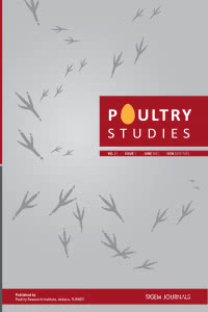Effect of Different Dietary Vitamin–Mineral Premixes, Housing Systems and Duration of Storage on Physical Characteristics and Proximate Compositions of Eggs at the Late Laying Stage
___
- 1. Patricio, I.S., 2003. Manejo do ovo incubável da grandja ao incubatório. In: Macari M, Gonzales: Facta. Pp. 163-179.
- 2. Leeson, S., Caston, L., 2003. Vitamin enrichment of eggs. The Journal of Applied Poultry Research; 12:24-26.
- 3. Asaduzzman, M., Jahan, M.S., Mondol, M.R., Islam, M.A., Sarkar, A.K., 2005. Efficacy of different commercial vitamin-mineral premixes on productive performance of caged laying pullets. International Journal of Poultry Science, 4: 5889-595.
- 4. Jones, D. R., Tharrington, J. B., Curtis, P. A., Anderson, K. E., Deener, K. M., Jones, F.T., 2002. Effect of cryogenic cooling of shell eggs on egg quality. Poultry Science. 81: 727- 733.
- 5. Jacob, J.P., Miles, R.D., Mather, F.B., 2000. Egg quality. University of Florida. http//:edis.ifas.ufl.edu/pdffiles/PS/PS02000.PDF
- 6. Ogunwole, O.A., Ojelade, A.Y.P., Oyewo, M.O., Essien, E.A., 2015. Proximate Composition and Physical Characteristics of Eggs from Laying Chickens Fed Different Proprietary Vitamin-Mineral Premixes Under Two Rearing Systems During Storage. International Journal of Food Science and Nutrition Engineering, 5(1) 59-67. doi: 10.5923/j.food.20150501.08.
- 7. Ogunwole, O. A. 2018. Effects of supplementing laying hens diets with different proprietary vitamin-mineral premixes and housing systems on egg properties and shelf life stability. Nigerian Journal of Animal Production 45(1): 279-295.
- 8. Lopez-bote, C.J., Arias, R.S., Rey, A.I., Castano, A., Isabel, B., Thos, J., 1998. Effect of free range feeding on omega-3 fatty acid and alpha-tocopherol content and oxidative stability of eggs. Animal Feed Science Technology, 72:33-40.
- 9. Van Den Bran, H., Parmentier, H. K., Kemp, B., 2004. Effects of housing systems (outdoor Vs cages) and age of laying hen on egg characteristics. British Poultry Science, 45, 745-752.
- 10. Basmacioglu, H., Ergul, M., 2005. Research on the factors affecting cholesterol content and some other characteristics of eggs in laying hens. Turkish Journal of Veterinary Animal Science, 29: 157-164.
- 11. Ojedapo, L.O., 2013. Effect of two housing systems (cages vs deep litters) on external and internal egg characteristics of commercial laying birds reared in derived savanna zone of Nigeria. Transnational Journal of Science and Technology 3(7),1857-8047.
- 12. Sauver, B., 1991. Effect of method of rearing of fowls on egg characters. Production Animales, 4, 123-130.
- 13. Kouba, M., 2003. Quality of oraganic products. Livestock Production Science, 80, 33-40.
- 14. Ogunwole, O.A., Ojelade, A.Y.P., Asuquo, C.E., 2016. Effect of proprietary Vitamin-Mineral Premix and housing systems on deposition of selected vitamins and selenium in chicken eggs at late laying phase. Tropical Veterinarian, 36(3) (Accepted)
- 15. A0AC. 2000. Official Method of Analysis of Association of Official Analytical Chemists. Int. 17th Edition. 2nd Revision. Gaithersburg,USA.
- 16. Tyler, C., 1961. Studies on egg shells. XVI. Variations in shell thickness over different parts of the same shell. Journal of the Science of Food and Agriculture, 12, 459-470.
- 17. Bhale, S., No, H.K., Prinyawiwatkul, W., Farr, A.J., Nadarajah, K., Meyers, S.P., 2003. Chitosan coating improves shelf-life of eggs. Journal of Food Science, 68(7): 2378-2383.
- 18. Haugh, R.R., 1937. The Haugh unit for measuring egg quality. US Egg Poultry Magazine 43:522-555, 572-573.
- 19. SAS, 1999. SAS/ STAT User’s guide Version 8 for Windows SAS Institute Inc.SAS.
- 20. Walsh, T.J., Rizk, R.E., Barke, J., 1995. Effect of temperature and carbondioxide on albumen characteristics, weight loss and long stored hatching eggs. Poultry Science. 74: 1003-1010
- 21. Latshaw, J.D., 1999. Ovomucin content and composition in chicken eggs with different interior quality. Journal of the Science of Food and Agriculture. 79(12): 1666-1670
- 22. Tabidi, M.H., 2011. Impact of storage period and quality on composition of table egg. Advances in Environmental Biology, 5:856-861.
- ISSN: 1302-3209
- Yayın Aralığı: 2
- Başlangıç: 1999
- Yayıncı: Tavukçuluk Araştırma Enstitüsü Müdürlüğü
Olugbenga Adeniran OGUNWOLE, Iretioluwa Adenike OLUDOYI, Akinola Yinka Paul OJELADE
Olugbenga Adeniran OGUNWOLE, Iretioluwa Adenike OLUDOYI, Akinola Yinka Paul OJELADE
Diyarbakır İli Köy Tavukçuluğunun Yapısı
Hakan İNCİ, Muhammed Ali EKİNCİ, Ersin KARAKAYA, Büyamin SÖĞÜT, Tugay AYAŞAN
Broylerlerde Florür Toksikasyonunun Duodenum, Jejunum ve Ileum üzerine Etkisi
İlkay AYDOĞAN, Ebru YILDIRIM, Ruhi KABAKÇI, Tuğçe SÜMER
Kebede Senbeta EWONETU, Asefa KASAYE
Omolade A. OLADELE, Oluwaseun O. ESAN, Iyabo A. ADETIBA, Ini L. AKPAN, Oluyemisi M. ADEWALE
Kebede Senbeta EWONETU, Asefa KASAYE
Abbas Fadhıl ABDULQADER, Osman OLGUN
Omolade A. OLADELE, Oluwaseun O. ESAN, Iyabo A. ADETIBA, Ini L. AKPAN, Oluyemisi M. ADEWALE
